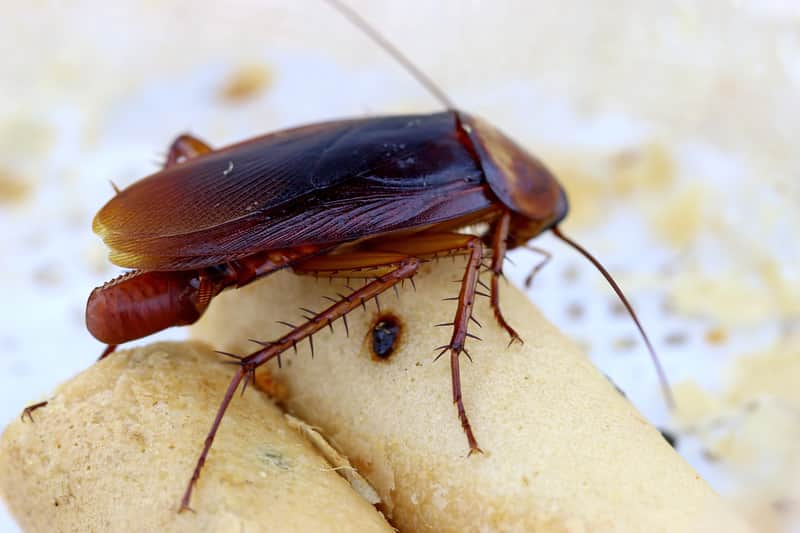While large American cockroaches are most likely to scare or surprise us when they show up inside our homes, the smaller German cockroach is the greater threat. That's because German cockroaches are the most common indoor cockroach species in the United States.

How many eggs can a cockroach produce each year?
German cockroaches have a higher egg production rate than most other cockroach species and higher rate than most of the common household species of cockroaches. A single female German cockroach and her offspring can produce up to 30,000 new cockroaches each year.
This ongoing birth cycle is why just a few small roaches can quickly turn into a cockroach infestation. A German female cockroach that continues to produce and hatch eggs over her 30-week lifespan can spawn two additional generations. Even if she doesn't produce the highest number of offspring possible, her efforts (and those of her descendants) can still bring in at least 10,000 new cockroaches to life within a year.
What do cockroach eggs look like?
The German female cockroach likes to lay her eggs in humid and warm areas of the home, such as the kitchen or bathroom. About 40 of these roaches' eggs are enclosed in an egg capsule that is light brown in color and about a quarter-inch long. Females are capable of producing a new egg capsule every few weeks under favorable conditions. The mother cockroach carries the capsule until a day or two before it hatches, then deposits it in a crevice or another protected place once hatching begins.
Where to look for cockroach eggs
German cockroaches like to be close to a reliable food source and fresh water. That's why they are often found in the moist, warm areas of our homes, like bathrooms and kitchens. These places also make an ideal nursery for the cockroach eggs and young cockroaches that have just hatched. Some favorite hiding places include:
Drawers, cupboards, and pantries
Plenty of privacy, enough food and access to water nearby makes these cool, dark places ideal cockroach habitats.
Inside appliances
Believe it or not, your kitchen appliances — and even your washer and dryer — could be home to cockroaches.
On and around baseboards
Cockroaches love to stay out of sight, so you'll often find them scurrying along the baseboards of your home, staying low and undetected.
Floor and bathtub drains
Water draws cockroaches like a magnet, and drains are a perfect place for them to hide.
Plumbing cabinets and water heater closets
These enclosed spaces are usually quite warm and moist — just the way cockroaches like it.
Consistently damp areas
Spaces with high humidity levels, like laundry rooms or bathrooms, can be inviting habitats for cockroaches.
Food storage or eating areas
Any place you eat or store food (for you or your pets) may be a likely place to find cockroaches.
Trash cans and recycling bins
Cockroaches aren't picky eaters, and even garbage will do, so trash cans and recycling bins are perfect homes.
How to prevent or control a roach infestation
German cockroaches can be difficult to eliminate because they multiply rapidly and are excellent at hiding. However, you can help reduce the chance of them moving in. A little maintenance, good sanitation practices and a reduction in clutter can help to prevent cockroaches from getting comfortable in your home. Here are some best practices to follow:
- Seal small cracks and crevices where roaches can enter, deposit eggs or hide.
- Inspect grocery bags, boxes and luggage before bringing them inside your home.
- Wipe up crumbs, seal up leftovers and clean up spilled food or drinks immediately.
- Don't leave used food plates or wrappers around the house.
- Wash dirty dishes, glasses, cups, utensils and cooking items as soon as possible after use.
- Empty the kitchen and bathroom trash daily, sealing the bags before placing them outside.
- Empty recycling bins each day, as well.
- Get rid of boxes, bags, newspapers and other clutter to help eliminate roach hiding places.
What to do if you find cockroach eggs
If you spot cockroach egg cases or egg capsules, you can begin to rid yourself of these nasty pests. To start, vacuum up cockroach egg capsules, young cockroaches and adults, when possible. Use a vacuum cleaner with a high-efficiency particulate air (HEPA) filter to help reduce cockroach debris that can become airborne and could trigger asthma attacks and other health concerns in people who are allergic to roaches.
Can cockroach eggs be killed?
There are, in fact, a few ways to destroy cockroach eggs. You could, of course, squash the egg capsule to destroy it, but if you have a large infestation or are squeamish, that might not be the most effective choice. While you may be tempted to sprinkle boric acid around the contaminated area, it's important to be careful when applying DIY roach killer solutions, as these can contain dangerous chemicals that could harm you or your family, including pets, or cause other issues if used incorrectly. Instead, if you spot cockroach eggs in your home, you should contact a pest control professional to get rid of cockroaches and other pests.
What's the best way to get rid of cockroach eggs?
The best way to kill cockroach eggs and eliminate adult roaches is to hire a pest control professional like Terminix®. Our technicians know everything there is to know about cockroaches and other household pests. They know where to look to find them, as well as how to get rid of them and keep them from coming back.
Get rid of your cockroaches today
Remember that if you see one cockroach, there may be many more that you haven't seen. If you're bothered by scurrying German cockroaches, American cockroaches or another type of cockroach, contact Terminix.

